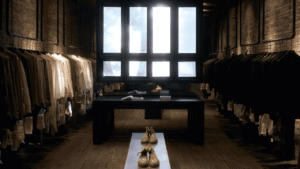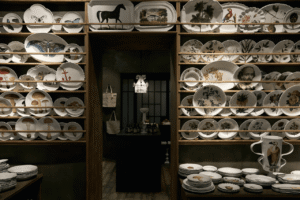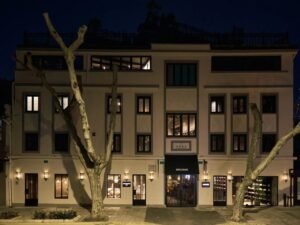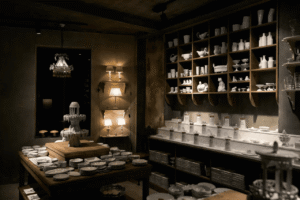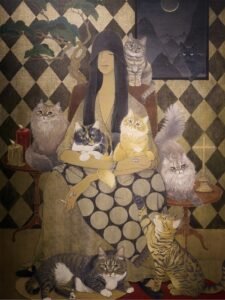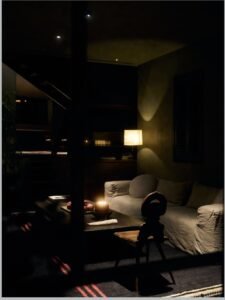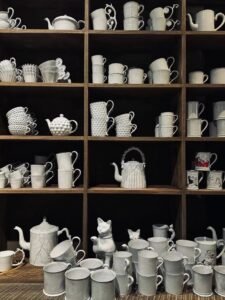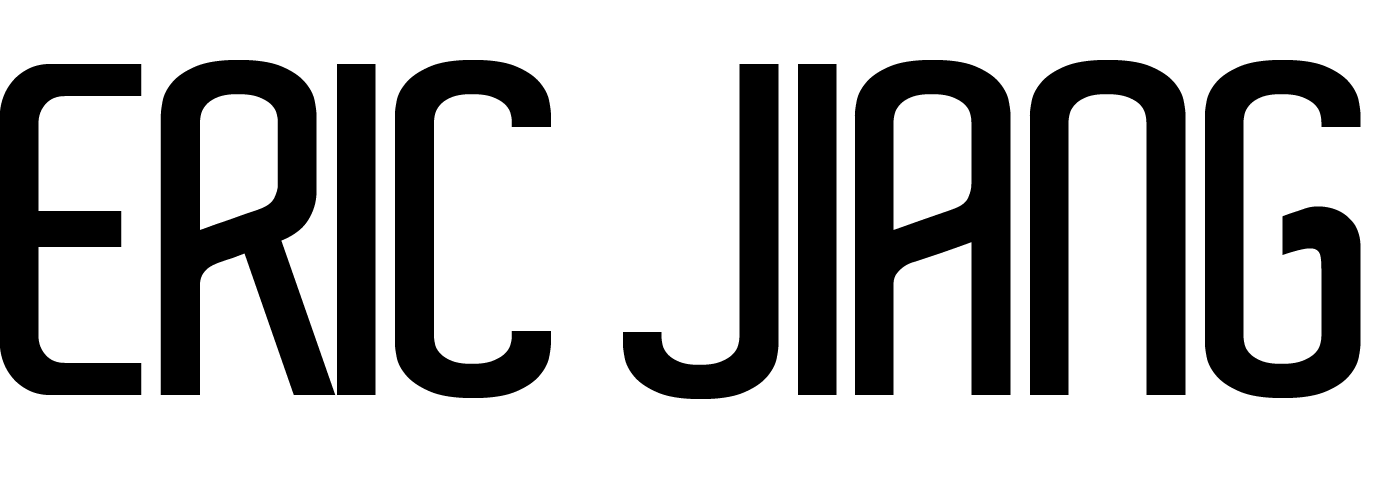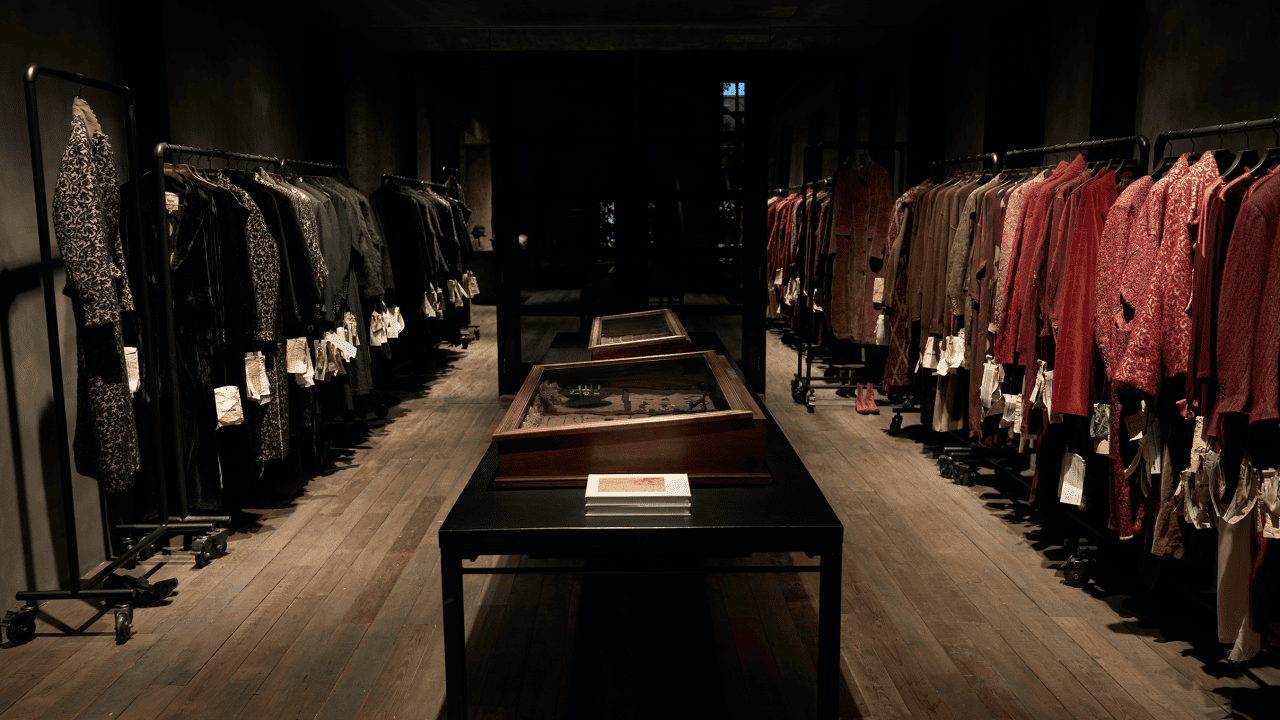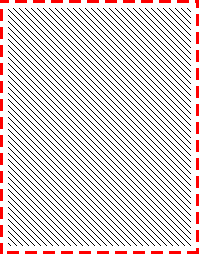In an exclusive conversation with Eric, Uma Wang discusses the philosophy behind her new Shanghai space.
By Eric Jiang
It has been a warm and sunny winter in Shanghai, and this was the atmosphere in which Maison Uma Wang opened its doors on 12th January. Curated by Uma herself, it is a physical home reflecting the designer’s signature approach to life, a place where the spiritual world is born as well as the speed of modernity is pitted against it. Stepping into the slightly darkened space, it is as if one has disappeared into a temporal sanctuary from the outside world.
Our interview was held the day before Chinese New Year’s Eve. I saw Uma coming downstairs from the top floor, “Is it Uma,” I called out to her. She turned around, dressed in a charcoal grey cashmere hoodie and slacks, holding a plain white ceramic cup in her hand with a silver ring on her index finger about three centimetres wide, and no make-up. “I am,” She replied.
The interview began ten minutes later. After having exchanged greetings, Uma descended the rest of the stairs and surveyed the shop, noticing the bouquets of flowers on the first floor that had collapsed, and told the clerk, “they can’t be left like this.” She then went into the in-house café and said, “be prepared when guests arrive.”
In 2014, Uma opened her shop in the townhouse known as Le Comptoir Français. Ten years later, she took over the entire building when she had been given access to a larger space. Starting in May of last year, she began to renovate and reimagine this approximately 1,200 square metre space. “It was purely by chance that I got this space back then, but the atmosphere of the entire villa is so grand that it takes time to master. It also requires the accumulation of brand value. That’s why we chose to expand at this particular moment.”
The staircase is the backbone of this space; the logic of the renovation cuts through here. “When I first saw this space, I found it really interesting because all the staircases are connected. The interior designer we were working with initially thought there were too many stairs and wanted to make them more orderly. But that would mean all the traffic would have to flow up and down through the main corridor – I felt that would be a bit monotonous.” She considered how the backbone could be refurbished and adjusted to hold up a new structure. “In the end, I made the staircase part of the rooms themselves. By giving the stairs a functional role, I also created a sense of layered, rebellious design, which encourages guests to have a mindset of discovery and exploration.”
So, the entrance to the Maison isn’t wide open; visitors must push through the carved black iron gate to reveal what’s inside. On the right side of the first floor, there are displays of Uma Wang’s scarves, shoes, and other accessories. On the left side is the boutique of the French porcelain brand Astier de Villatte. Among the dazzling array of milky white porcelain, candles and fragrances have been intentionally scattered. When I lifted the bottle caps and took a sniff, different warm, spicy aromas immediately filled my nose – these are scents that have accompanied Uma for over twenty years.
“You’ve always been known as someone who values keeping a distance from the outside world. Do you feel uncomfortable showing some of your personal preferences this time?” I asked.
“No,” she waved her hand as she sat on the sofa. “In the past, I wasn’t very willing to share. For example, fragrance. To me, it was something as personal as underwear. But in recent years, my mindset has become more open. I feel it’s time to share the things I love, including some of the objects I’ve encountered on my travels. I want the Maison to be a comprehensive showcase, where people can experience a sense of systematic beauty, a unique way of seeing, even a philosophy.” This kind of exposure is probably still very Uma style, retaining her usual cautiousness.
The second floor is dedicated to Uma Wang’s menswear and womenswear collections, while the mezzanine leading to the top floor currently houses the handmade eyewear brand Rigards. Uma has been collaborating with Rigards for six years – the name is derived from French and directly translates to ‘see’. Each pair of glasses is placed on a long, slender wire stand, with labels beneath them explaining the materials, such as horn, titanium alloy, or other metals. Soft, warm lighting casts shadows of the frames on the wall, intertwining in intricate patterns.
“The top floor is my reception area, and also serves as a fitting room for some guests,” Uma explained. In the spacious room, there was a soft, neutral-coloured sofa, a diamond-patterned rug, and a coffee table – on it, a plate of Red Delicious apples and some books. “To ensure the privacy of this space, I removed one staircase, leaving this room with only two doors, while all the other rooms can seamlessly connect and interact with each other,” she added. “Overall, I wanted the Maison to have a bit of a maze-like feel.”
Climbing up the four steps on one side of the reception area led to a space resembling a dining room. Further up, a rooftop garden filled with plants awaited, with a view of neatly arranged residential buildings in the distance, and right below, small villas with red-tiled rooftops.
Uma’s fascination with the concept of “winding paths leading to secluded places” runs through both her aesthetic and her personality. She describes herself as a “typical Taurus,” always disliking overly direct forms of expression – not because she resists communication, but because she finds beauty in leaving some things unsaid. Yet, she also enjoys digging deep and seeks objective answers to things.
“I have many confident friends around me who believe that it’s fine for others to see their imperfect side. I really admire this quality, but it’s not something I have,” she said, shifting slightly forward on the sofa. “I tend to test if you like something first. If you do, I’ll show you a bit of it, but if you furrow your brow even slightly, I’ll immediately pull back.” She then leaned back into her original position on the sofa.
Outside the reception area is an exhibition space, with a series of portrait paintings by artist Guan Chun hanging on the wall. The subjects in the paintings are dressed in Uma Wang and sitting gracefully at their homes, surrounded by their beloved pets. The painting Guan created of Uma and her cats hangs directly opposite the wooden door of the reception area. Uma loves cats and has eight of them.
“After the pandemic, many of my designer friends have struggled with their businesses. I approached the creation of this space with a primal impulse, wanting to bring in things from my good friends; anything I love can be directly presented to consumers here,” she continued. “Now, every time we meet, everyone is complaining about the tough environment, but talking too much about it only brings people down. I still hope to bring something refreshing to everyone within my abilities, to give people confidence and boost morale.”
In Uma’s life, there seems to be an inexplicable sense of mission; this doesn’t come from within herself, but rather from a deep sense of responsibility toward others.
She recalls her school days, when, as the class monitor, she would help her female classmates with questions about their menstrual cycles. During the Chinese New Year, when buying new clothes, her friends would borrow her for two hours to go to the town together, trusting her taste more than her parents’. Nowadays, her team members occasionally call her “Mama Uma.” At this point, she smiles wryly. Many tasks could easily be handled by her assistants, but she still finds herself habitually taking on extra responsibilities. That urgent feeling of wanting to help others find answers drove her to take action, accumulate experiences, and, in a way, pushed her to gradually find her own place and voice.
“Other people’s trust is very important to me. That trust motivates me to do things well,” she said. “When I first started the brand, I never imagined it would come to this point. It was purely because a senior I deeply respected placed their trust in me. When they said, ‘You can do it,’ I felt I had to move forward.”
In the early 2000s, Uma graduated from China Textile University and then went on to study at Central Saint Martins in London. In 2006, Uma Studio launched its first knitwear-focused collection. At that time, Chinese designers were still hesitant to use their own names for their brands, fearing it would negatively impact sales. Three years later, Uma decided to use Uma Wang as the brand name. In 2011, the brand was officially included in the Milan Fashion Week schedule and soon after began collaborating with material suppliers and manufacturing factories in Quistello, Italy, gradually shifting its production and sales centre to Italy. In 2017, Uma Wang officially debuted at Paris Fashion Week, showcasing two seasons of womenswear each year at the American Cathedral.
Looking back at the evolution of Uma’s collections in recent years, I noticed a subtle shift in her design language. In the past, Uma’s designs gave off an impression of calmness and rationality, like sitting between black-and-white stone pillars. Over these last three years, however, she seems to have opened up a little, with jacquard fabrics processed from the inside out expressing a feeling of sensitivity. The quirky, fuzzy silk threads, along with the carefully balanced exposures at the shoulders, neck, back, and ankles, add an air of effortless, refined sensuality.
At the same time, Uma has become more attuned to nature. Her travels through Europe and the tropics have inspired her to weave nature, history, and culture into the narrative of her collections. As a true “fabric enthusiast,” she incorporates coffee dye, bark-like cotton, and metal into the textures of her designs. If a garment needs to convey the idea of clouds, she uses transparent nylon as a symbolic interpretation. For Uma, the essence of nature lies in mimicry, not in realism – this is the unique nature of Uma Wang.
It seems that Uma is slowly breaking through her own nature. “In recent years, I really have felt a sense of clarity,” she said. “Things that used to feel like the world was about to collapse now often just feel like ‘it’s fine.’ The difficulties that would wake me up in the middle of the night, when I would obsessively wonder ‘What should I do,’ now I don’t even think they’re a big deal anymore.”
But she still has her moments of feeling like “I’ve got a problem.” “When I was designing the diamond-patterned wall on the first floor, I wanted to capture the feeling of decay from a church near my home in Verona, Italy. But after several attempts, it just wasn’t right. So, one evening, I went home and prayed,” she said, naturally bringing her hands together. “I said, ‘God, I’ve got a serious problem here. I just can’t get this wall right. Can you help me?’”
The next day, she witnessed a miracle. She opened the door and saw the workers removing the excess from the wall on the first floor. “The black tiles on the wall protruded two millimetres more than the white ones. When they leveled those two millimetres, the wall’s distressed texture suddenly came to life. In the end, we used a sponge brush dipped in coffee-coloured paint to apply another layer, and it turned out exactly as I had imagined.” Looking back, Uma still feels it’s unbelievable. “It was truly such a pleasant surprise.”
What’s interesting is that Uma’s own home is completely different from the Maison. “My home is all white with coffee-coloured wood floors – nothing else,” she said. “Because I have to look at so many different fabrics and prints every day, I can’t have anything extra in my home, or else my eyes would get overwhelmed.”
This minimalist approach also extends to her everyday clothing habits. Those who know Uma well are aware that she most often wears Uniqlo. Her wardrobe is filled with Uniqlo puffer jackets and underwear. For her, basic pieces offer comfort and a lack of aggression. A simple, solid-coloured T-shirt allows her to blend into the crowd and go unnoticed, which she finds reassuring.
Typically, Uma is woken up in the morning by her cats. After completing the big tasks of feeding them and cleaning the litter boxes, she gets ready and heads to the office for work. At 4pm, when it’s time for work in Italy, she starts meetings with various departments there, working until 2am in China. “It’s been very busy lately, but I hope this state doesn’t last too long,” she said, laughing.
As I was leaving, I passed by the transparent glass on the left side of the reception area. Perhaps a guest hadn’t noticed it and bumped into it, leaving a foundation mark on the glass. The winter sunlight filtered through the window, softening the indoor space and making the imperfection on the glass even more noticeable. She spotted the mark, smiled, and then escorted me to the door. As soon as I left, she turned around and walked back into the room, back into her life.
